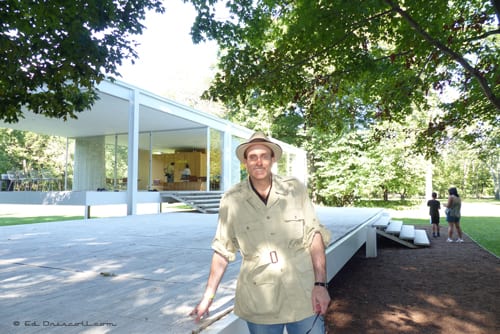THE MAGNIFICENT FIASCO OF MIES VAN DER ROHE’S FARNSWORTH HOUSE:
It is an astonishingly beautiful building, as visceral as it is intellectual. The way in which elementary materials and ‘nearly nothing’ have a transcendent effect is profound. It floats, perfect proportions denying material weight. From outside it looks agreeably alien; from inside, its transparency makes landscape captive. And the architect’s attention to the logic of structure and to detail is revelatory. Rivet heads were painstakingly ground off at steel junctions to make visually perfect joints. The frame is made with such fanatical precision that it responds to impacts like a tuning fork. As a whole, the Farnsworth House improves upon nature, which was Voltaire’s definition of art.
Yet it is absurd. Mies insisted on building on the Fox River’s floodplain, the better to enjoy the local woods. He refused thermally efficient double-glazing. Only after protest was Farnsworth allowed a wardrobe; Mies said it was a weekend house and the necessary single dress could be hung out of sight behind the bathroom door. He was adamant that his own furniture designs were used rather than his client’s preferences. Moreover, his architectural training had not included Mechanical & Electrical Services, so he knew nothing of plumbing, heating, air-conditioning, drainage or power supply. Water seepage from above complemented the rising damp caused by the turbulent, intrusive Fox below. The house was an oven in summer and a freezer in winter. Ugly stains soon appeared. When Farnsworth complained about the exiguous fireplace, Mies said: ‘Get smaller logs.’
The original budget had been $10,000.But this ‘functionalist’ architect was notoriously sloppy in business, and the account came to seven times as much. Despite his managerial incompetence, Mies took Farnsworth to court over unpaid fees and won. Her revenge was to fill the house with unsuitable furniture — and eventually to go to live in Italy (where her relationship with the poet Eugenio Montale was another episode of Euro-flavored unrequited love).
Farnsworth House is a magnificent catastrophe, a manifesto of designer arrogance, a maintenance nightmare, an unlivable space where God fought with Satan over the details, especially the boiler and drains. And it is now a national monument, a pilgrimage site for architecture students from all over the world. Widely imitated (by designers whom Nikolaus Pevsner called ‘three blind Mies’), it has never been bettered. In a sense, it couldn’t be.
The house would fare much better when British real estate developer Peter Palumbo bought it from Edith Farnsworth in 1972. He installed furniture that Mies and his Bauhaus-era partner Lilly Reich had designed, and removed the hideous screens from its jutting front podium. But as Mies’ biographer, the late architectural historian Franz Schulze wrote for the program accompanying a 1982 Arts Club of Chicago exhibition focusing on Mies’s interiors:
To dust the furniture or wash the dishes in the Farnsworth House on a hot summer’s day in the steaming Fox River valley with the hermetically sealed windows interrupted by only the smallest ventilating apertures in the rear of the place, is to realize that this is not an environment formed in response to “the demand for realism and functionalism.”
On the other hand, to approach the house, this abstract temple whose white geometry is set in relief against the green woods overlooking the river, then to mount the floating steps to the podium, to study the serenity of the proportions of its steel skeleton and its precision fabrication, to enter a totally glazed interior and hover there, between the space of an ordering mentality and the setting of a limitless nature, the one separated from the other by the immateriality of glass, is to an experience an architecture which has ascended to the realm of the mystical.
if you have any interest in architecture, it’s well worth taking the hour drive out of Chicago to visit the Farnsworth House in person.

